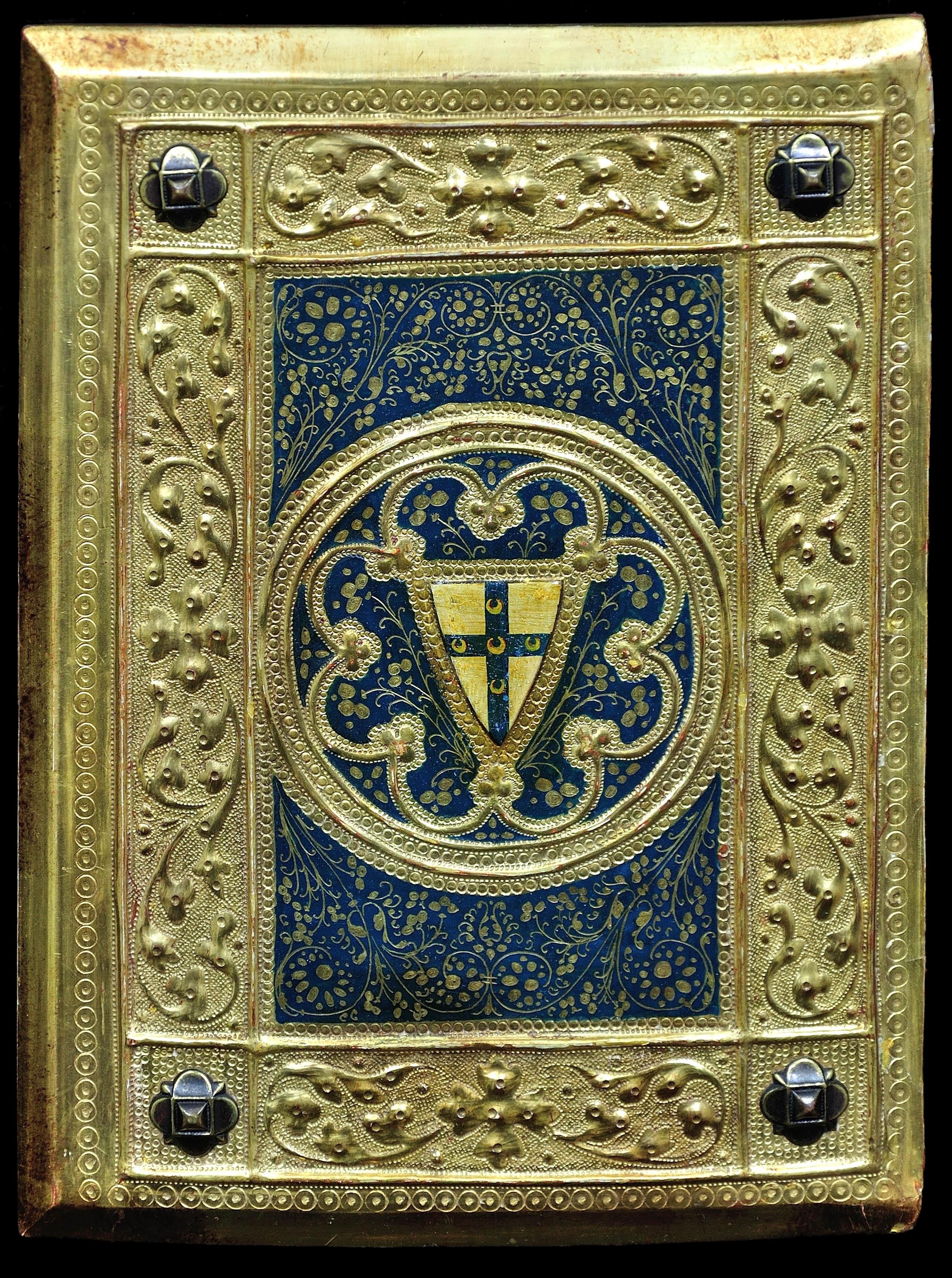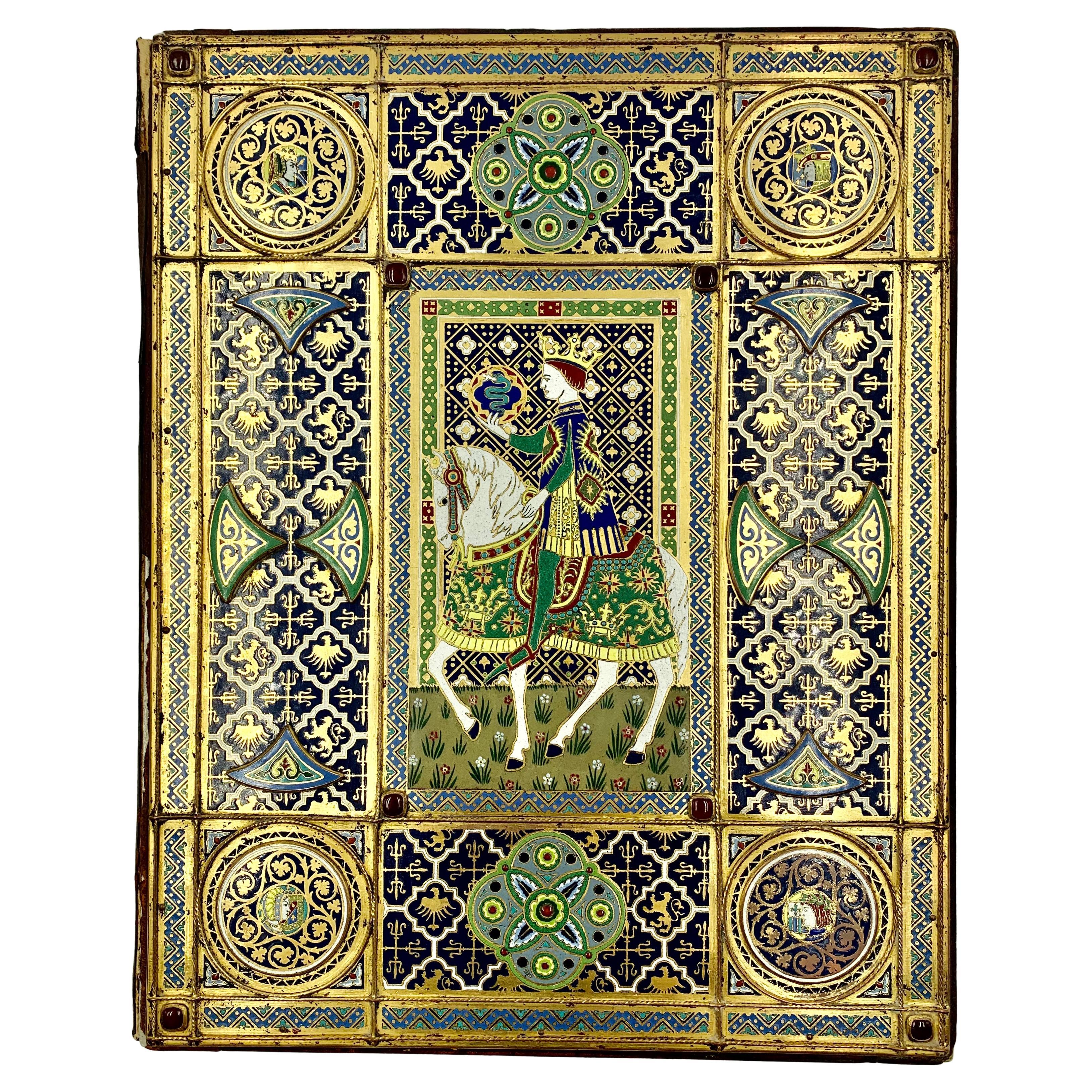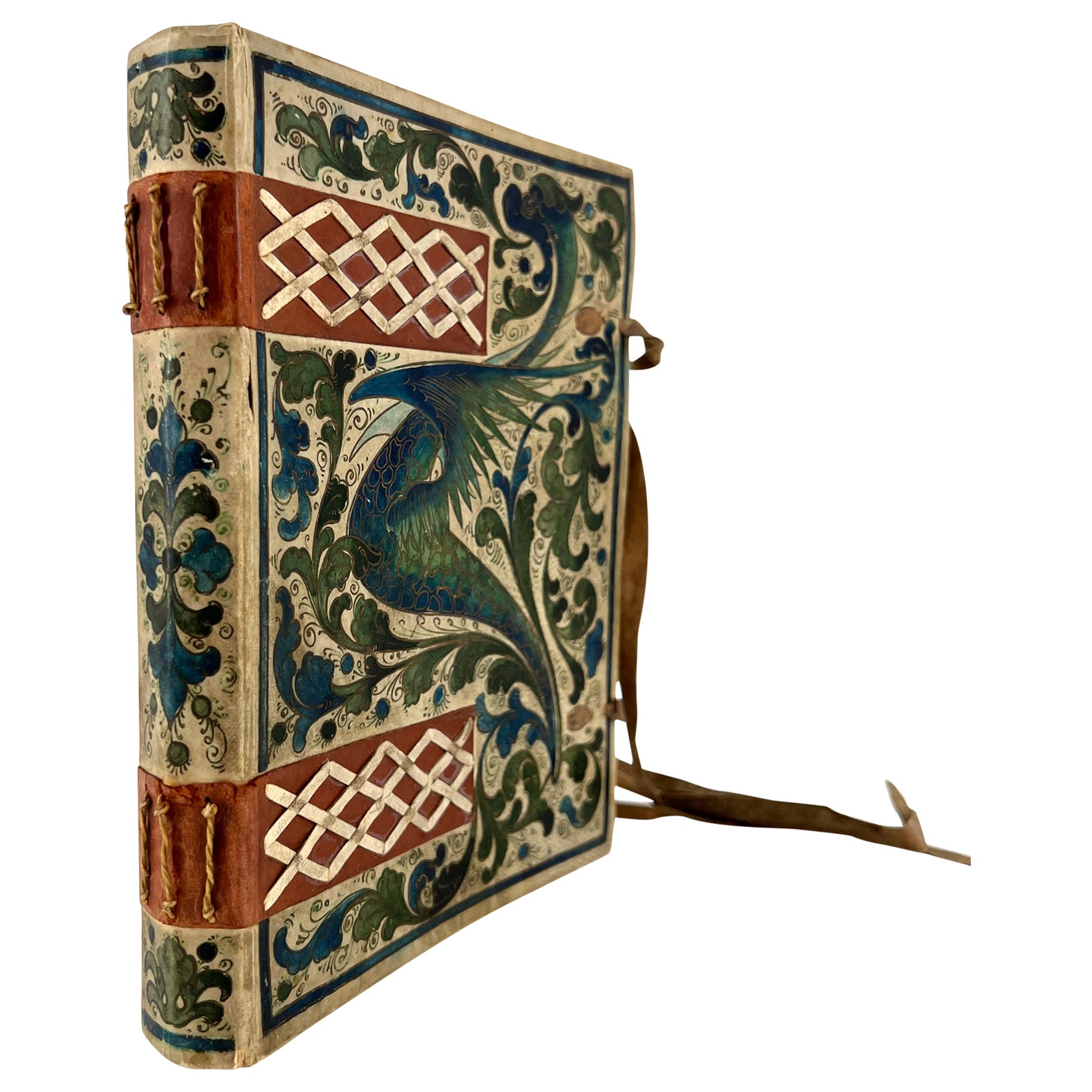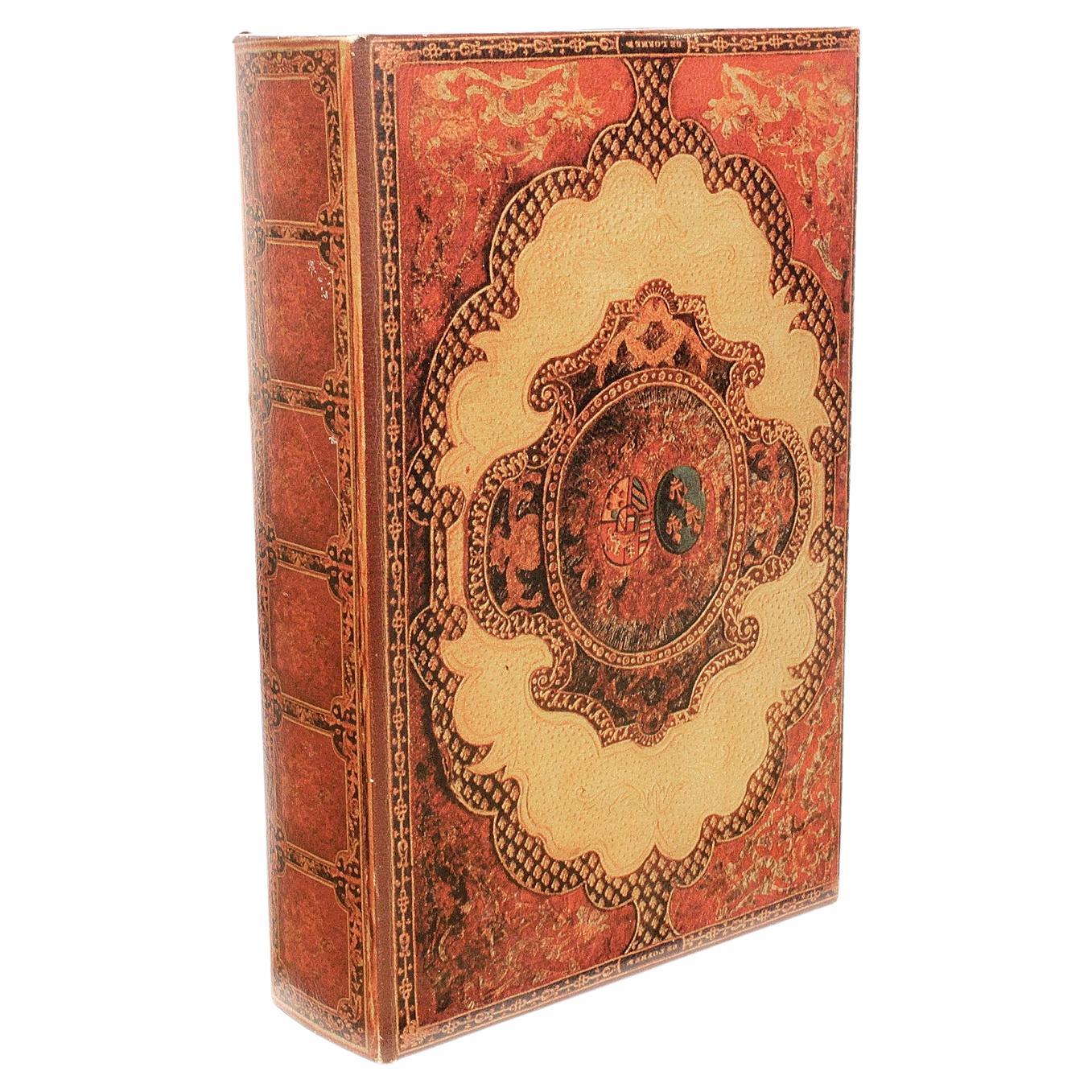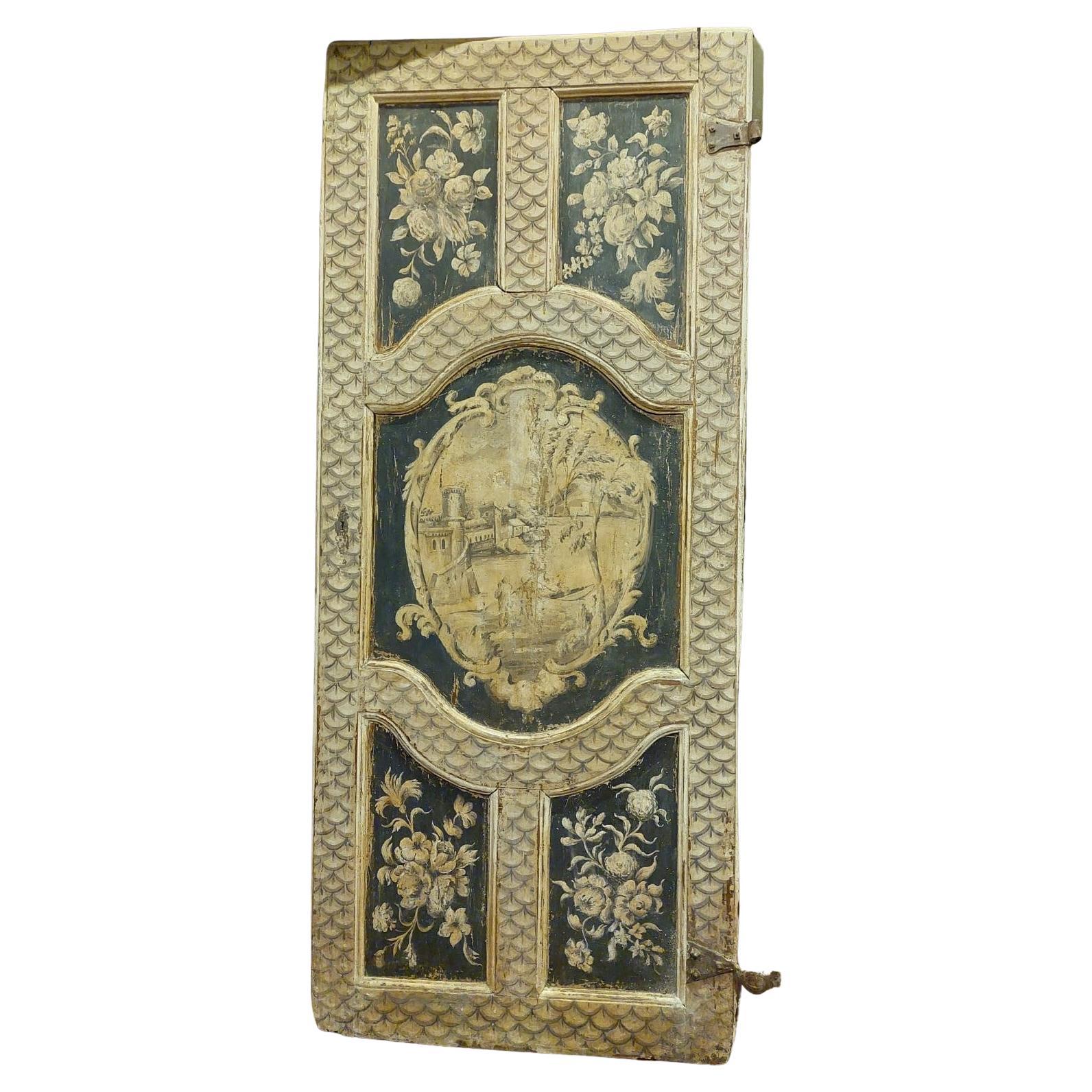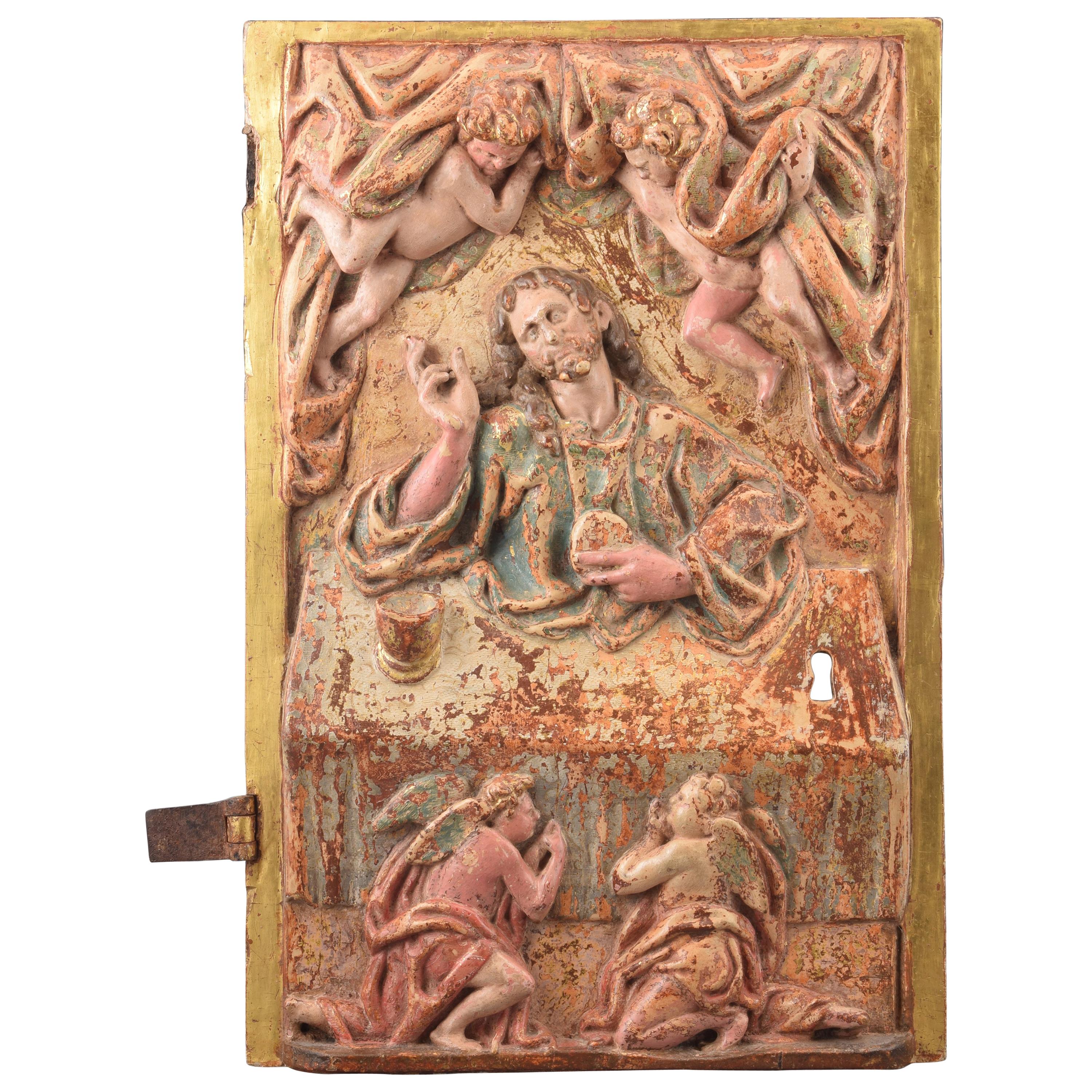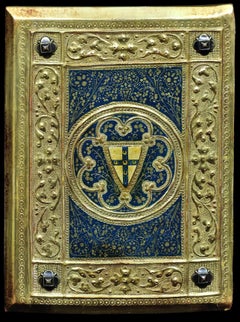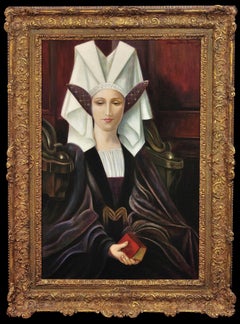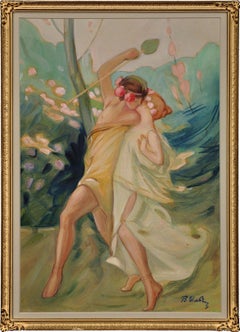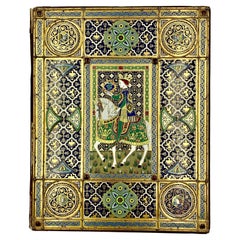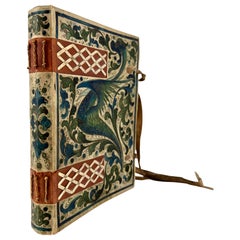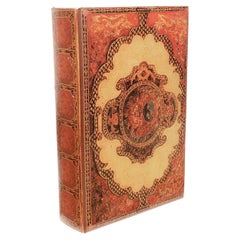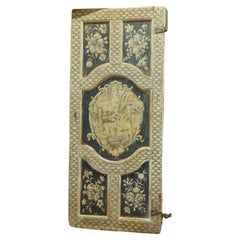Items Similar to Painted Wood Tavolette Book Cover Binding The Biccherna Aesthetic Siena Tuscany
Want more images or videos?
Request additional images or videos from the seller
1 of 21
Icilio Federico JoniPainted Wood Tavolette Book Cover Binding The Biccherna Aesthetic Siena Tuscany
$10,916.91
£7,895
€9,303.65
CA$15,125.92
A$16,423.81
CHF 8,697.61
MX$201,308.85
NOK 107,636.33
SEK 101,710.64
DKK 69,438.62
About the Item
Icilio Federico Joni.
Italian ( b.1866 - d.1946 ).
Painted Gesso, Gilt & Wood Tavolette Book Cover Binding In The Sienese Biccherna Aesthetic.
Book Cover size 11 inches x 8.1 inches ( 28cm x 20.5cm ).
Frame size 16 inches x 13 inches ( 40.5cm x 33cm ).
Available for sale; this painted gesso and gilt “tavolette” wooden book cover in the Biccherna aesthetic is by Icilio Federico Joni.
The book cover is mounted and supplied in a contemporary black Tulip Wood frame (which is shown in these photographs) which is glazed with non-reflective Tru Vue UltraVue® UV70 glass. The wooden book cover is curved and float mounted giving a wonderful 3D depth to its presentation.
The gesso and painted surfaces have benefitted from professional restoration which was performed on our instruction, supervision and approval.
This antique book cover is in very good condition, commensurate with its age.
The frame presentation is new and in excellent condition. Combined, it wants for nothing and is supplied ready to hang and display.
The story of these panels and of their artist is fascinating, and begins in 13th century Siena:
The Biccherna was the person who held the position of Magistrate of Chancellery of Finance from the 13th to the 14th century for the republic and the city of Siena, in the Tuscany region of Italy. The records of that office were very important because Siena was one of the earliest and most significant banking centres in Italy, and indeed in Europe. It became the fashion to keep banking and taxation records of the region in large books with painted leather covers. These were originally made from wood and leather. In the competition to make these ever more prestigious the bindings and panels on the front and rear of the books were painted by the major artists of the day, such as Giovanni di Paolo. Many of these mainly secular covers are displayed in the Archives of the State of Siena located in the Palazzo Piccolmini.
The Gothic Revival of the 19th century occurred partly as a reaction against the progress of industrialisation in Europe generally. It was however greatly affected by the unification of Italy in the second half of the 19th century. This led to the closure and downsizing of many religious institutions, which resulted in the dispersal of thousands of works of art dating from the Middle Ages and early Renaissance. Many aristocratic and bourgeois families struggled to pay debts or simply to make ends meet and so they sold off their private collections and family heirlooms. There was then an influx of goods into the antiques market which provided a great deal of work for Italy’s restorers and craftsmen, since many of these pieces were in need of cleaning, repair and, in keeping with the interventionist tastes of the times, radical restoration, before they could be sold on, often to foreign buyers. These early Italian works became so fashionable that demand soon outstripped supply. This in turn gave rise to a new type of artist-craftsman capable of turning out from scratch increasingly convincing reproductions, imitations and out-and-out fakes.
Siena naturally became the epicentre of this thriving cottage industry because of the extraordinary continuity there in traditional craft skills. This technical expertise had been handed down from generation to generation, and it was perhaps inevitable that a number of artists with real talent, the flair of commerce and a genuine love and understanding of antique Sienese art should adapt their skills to these new market conditions. Among these artists were Igino Gottardi, Alceo Dossena, Fulvio Corsini, Umberto Giunti, Bruno Marzi and Icilio Federico Joni. Their works ended up in virtually every major art gallery, museum and private collection in the world. Joni was the most celebrated of these artists and came to be called the “Prince of Sienese Forgers”.
These artists did not usually operate in a clandestine manner, as least as far as most of their supply to the art dealers of Florence, Venice and Rome were concerned. It is interesting to note that they operated close to the premises from which export licenses were granted, and they could only obtain an export licence by proving that the work they produced was a reproduction or fake of a much earlier period. Initial supply was therefore often on the basis that their works were modern imitations of old masters. The dealers however were often unscrupulous and in turn often sold these to their clients as the genuine article.
In 2004 Sienese professor of art history Gianna Mazzoni curated an immaculately researched and visually sumptuous exhibition entitled “Falsi d’autore” (Fakes by Master Artists). This told the story of these great art fakers and argued that it was time for their works to take their place in the general history of 19th and 20th century Italian art.
Joni was the most famous of the Sienese painters and restorers who produced imitations of the wooden panel bindings, the Tavolette di Biccherna. He was born in 1866 and lived all his life in the region of Sienna. He was a classically trained artist and worked in Siena’s art restoration business in various capacities. He restored works, fabricated works and even flat-out faked works by famous masters of Italian Medieval and Renaissance art.
One on the many areas in which Joni excelled was the creation of the Tavolette di Biccherna. By around he 1890 he was a skilled produced of imitation “Gothic” altarpieces and he received a commission to create a book cover in imitation of those found on a Tavole di Biccherna. Although he had never visited the city archives to inspect the originals, he soon established a lucrative business of faking these covers. Ironically, his bindings are in fact anachronistic as from 1459 the wooden panels began to be bound with leather, yet Joni gave his wooden panel bindings dates post-1459. His undetected imitation bindings have graced some of the greatest book collections, including those of Hoe and Wilmerding. Joni later boasted of incidents in which local police were alerted to books purportedly stolen from Siena Cathedral or the state archives, only to discover they were by Joni. Even recognised as imitations, they had great cachet, as the commission by Lady Wantage for a binding in 1904 demonstrates.
Joni and his fellow “fakers” were sometimes quite legitimately called upon to apply their skills to make faithful copies of genuine works, for instance, when an owner wished to sell an original but keep a less valuable version. The existence of such copies inevitably led to a considerable degree of confusion, with some copies coming to be regarded as originals and vice versa. Some of Joni’s works were so admired – whether with or without the knowledge that they were fakes is unclear – that they were assiduously copied by other artists, creating a subgenre of fakes of fakes. Overall, only a relatively small part of Joni’s production consisted of direct copies, his “original” fakes being harder to detect. Indeed, he took some pride in the idea that he was making something new, and wrote that an artist “who creates a work of art of his own, in imitation of the aesthetic of an old master, is not a forger; he is at worst an imitator, and he is creating something of his own”.
Joni wrote his autobiography (Memories of a Painter of Antique Pictures) despite being offered a substantial sum to desist by a large consortium of Italian art dealers, who did not want him to reveal the ‘goings-on” of the trade in antiquities. Joni’s autobiography has been described as a small masterpiece in ambiguity, of things said, not said and implied. It was first published in 1932, and an English version was published in 1936. In it he openly described his forgery work.
Joni had an adventurous and interesting life. He was a flamboyant character, knew many important people and was friends with leading historians of his day, such as Bernard Berenson. He was an undeniably talented painter, gilder and restorer and possessed extraordinary mimetic qualities. He also had several mistresses, produced pageants, played the mandolin and used his studio, where he kept falcons, as a gymnasium!
Today Joni’s forgeries are highly valued in their own right. At least 14 of Joni’s works are recorded and more are in circulation. Given the undeniable beauty of his tavolette binding works it is not surprising that there is a burgeoning market in the best of these pieces, which are now themselves genuine antiques. The Bridwell Library at the Southern Methodist University in Dallas, Texas, possesses a rare “genuine” Joni, that was produced as a commission for a specific book. There is another in the Beinecke Rare Book & Manuscript Library at Yale University, New Haven, Connecticut.
This artwork we are now offering for sale is a wooden panel, originally forming the binding cover of a book and was produced by the most famous Italian ‘forger’ Icilio Federico Joni. The panel is created in the image of those produced in Siena in the 13th to 17th centuries and known as Tavolette di Biccherna.
© Big Sky Fine Art
This slightly arched wooden cover has a central panel on which is painted a scene depicting three figures. These is a male and a female standing in the foreground, holding hands. Behind them is a senior clerical figure, likely a bishop. All three figures are wearing highly decorated courtly clothing. This may well be a wedding or blessing ceremony. In the background is a pleasant open area, resembling a walled garden within a town. Above the main scene is a smaller panel with three heraldic shields in a row, the middle one bearing the letters OPH. All around the edges of the panel are wide gilded panels which are richly decorated and form an arabesque frame. In each corner there is a hemispherical brass boss. The whole piece has been professionally restored and is in excellent condition. The colors are simply stunning. It is mounted within a modern black box frame behind museum quality non-reflective glass in a way which perfectly displays its three-dimensional qualities.
- Creator:Icilio Federico Joni (1866 - 1946, Italian)
- Dimensions:Height: 15.95 in (40.5 cm)Width: 13 in (33 cm)Depth: 1.97 in (5 cm)
- Medium:
- Movement & Style:
- Period:
- Condition:This antique book cover is in very good condition, commensurate with its age. The frame presentation is new and in excellent condition. Combined, it wants for nothing and is supplied ready to hang and display.
- Gallery Location:Sutton Poyntz, GB
- Reference Number:1stDibs: LU489314149802
About the Seller
5.0
Gold Seller
Premium sellers maintaining a 4.3+ rating and 24-hour response times
Established in 2010
1stDibs seller since 2016
123 sales on 1stDibs
Typical response time: 1 hour
- ShippingRetrieving quote...Shipping from: Sutton Poyntz, United Kingdom
- Return Policy
Authenticity Guarantee
In the unlikely event there’s an issue with an item’s authenticity, contact us within 1 year for a full refund. DetailsMoney-Back Guarantee
If your item is not as described, is damaged in transit, or does not arrive, contact us within 7 days for a full refund. Details24-Hour Cancellation
You have a 24-hour grace period in which to reconsider your purchase, with no questions asked.Vetted Professional Sellers
Our world-class sellers must adhere to strict standards for service and quality, maintaining the integrity of our listings.Price-Match Guarantee
If you find that a seller listed the same item for a lower price elsewhere, we’ll match it.Trusted Global Delivery
Our best-in-class carrier network provides specialized shipping options worldwide, including custom delivery.More From This Seller
View AllPainted Wood Tavolette Book Cover Binding The Biccherna Aesthetic Siena Tuscany
By Icilio Federico Joni
Located in Sutton Poyntz, Dorset
Icilio Federico Joni.
Italian ( b.1866 - d.1946 ).
Painted Gesso, Gilt & Wood Tavolette Book Cover Binding In The Sienese Biccherna Aesthetic.
Book Cover size 11 inches x 8.1 inches ( 28cm x 20.5cm ).
Frame size 16 inches x 13 inches ( 40.5cm x 33cm ).
Available for sale; this painted gesso and gilt “tavolette” wooden book cover in the Biccherna aesthetic is by Icilio Federico Joni.
The book cover is mounted and supplied in a contemporary black Tulip Wood frame (which is shown in these photographs) which is glazed with non-reflective Tru Vue UltraVue® UV70 glass. The wooden book cover is curved and float mounted giving a wonderful 3D depth to its presentation.
The gesso and painted surfaces have benefitted from professional restoration which was performed on our instruction, supervision and approval.
This antique book cover is in very good condition, commensurate with its age.
The frame presentation is new and in excellent condition. Combined, it wants for nothing and is supplied ready to hang and display.
The story of these panels and of their artist is fascinating, and begins in 13th century Siena:
The Biccherna was the person who held the position of Magistrate of Chancellery of Finance from the 13th to the 14th century for the republic and the city of Siena, in the Tuscany region of Italy. The records of that office were very important because Siena was one of the earliest and most significant banking centres in Italy, and indeed in Europe. It became the fashion to keep banking and taxation records of the region in large books with painted leather covers. These were originally made from wood and leather. In the competition to make these ever more prestigious the bindings and panels on the front and rear of the books were painted by the major artists of the day, such as Giovanni di Paolo. Many of these mainly secular covers are displayed in the Archives of the State of Siena located in the Palazzo Piccolmini.
The Gothic Revival of the 19th century occurred partly as a reaction against the progress of industrialisation in Europe generally. It was however greatly affected by the unification of Italy in the second half of the 19th century. This led to the closure and downsizing of many religious institutions, which resulted in the dispersal of thousands of works of art dating from the Middle Ages and early Renaissance. Many aristocratic and bourgeois families struggled to pay debts or simply to make ends meet and so they sold off their private collections and family heirlooms. There was then an influx of goods into the antiques market which provided a great deal of work for Italy’s restorers and craftsmen, since many of these pieces were in need of cleaning, repair and, in keeping with the interventionist tastes of the times, radical restoration, before they could be sold on, often to foreign buyers. These early Italian works became so fashionable that demand soon outstripped supply. This in turn gave rise to a new type of artist-craftsman capable of turning out from scratch increasingly convincing reproductions, imitations and out-and-out fakes.
Siena naturally became the epicentre of this thriving cottage industry because of the extraordinary continuity there in traditional craft skills. This technical expertise had been handed down from generation to generation, and it was perhaps inevitable that a number of artists with real talent, the flair of commerce and a genuine love and understanding of antique Sienese art should adapt their skills to these new market conditions. Among these artists were Igino Gottardi, Alceo Dossena, Fulvio Corsini, Umberto Giunti...
Category
Late 19th Century Renaissance More Art
Materials
Gesso, Oil, Wood Panel
One Thousand And One Nights French Orientalism Art Nouveau Decorative Period
Located in Sutton Poyntz, Dorset
A. Lesueur
French 19ème siècle
Les Mille Et Une Nuits – One Thousand & One Nights, 1892
Charcoal on paper heightened with white.
Signed & dated 1892 lower right.
Image size 23.6 inc...
Category
Late 19th Century Romantic Animal Drawings and Watercolors
Materials
Paper, Charcoal
Framed Bretagne Breton Symbolist Oil Painting Circa 1910 Liturgical Costume
By Edgard Maxence
Located in Sutton Poyntz, Dorset
Follower of Edgard Maxence.
French ( b.1871 - d.1954 ).
Meditation, Circa 1910.
Oil On Canvas.
Image size 34.4 inches x 22.2 inches ( 87.5cm x 56.5cm ).
Frame size 44.1 inches x 31.9...
Category
Early 20th Century Symbolist Figurative Paintings
Materials
Canvas, Oil
Framed Art Nouveau Period Painting A Greek Love Affair Theseus And Ariadne
By Antoine Calbet
Located in Sutton Poyntz, Dorset
Follower of Antoine Calbet.
French ( b.1860 - d.1944 ).
Theseus and Ariadne, Circa 1890 - 1910.
Mixed Media.
Watercolour, Gouache & Pastel
Image size 16.5 inches x 11.2 inches ( 42cm...
Category
Early 1900s Art Nouveau Figurative Paintings
Materials
Paper, Pastel, Watercolor, Gouache
Framed 1860s French Academic Style Oil Painting Romantic & Mythological Themes
By André Charles Voillemot
Located in Sutton Poyntz, Dorset
André Charles Voillemot.
French ( b.1822 - d.1893 ).
Allegory Of Summer.
Oil On Canvas.
Signed Lower Left.
Dedication Lower Left To Victorien Sardou (1831 – 1908).
Image size 18.1 in...
Category
Mid-19th Century Academic Nude Paintings
Materials
Oil, Canvas
By Queen Victoria's Daughter Princess Alice Framed Royal Watercolor Painting
By HRH Princess Alice Maud Mary Hanover
Located in Sutton Poyntz, Dorset
Queen Victoria’s Daughter, HRH Princess Alice Maud Mary, Of The House of Hanover.
The British Royal Family.
British ( b.1843 - d.1878 ).
Long Life And Happiness – June 11th 1860.
Wat...
Category
Mid-19th Century Victorian Figurative Drawings and Watercolors
Materials
Watercolor, Ink, Pencil
You May Also Like
Edward F. Caldwell Gothic Style Jeweled Champleve Enamel Antique Folio Cover
By Edward F. Caldwell & Co.
Located in New York, NY
A very rare, fine large Edward F. Caldwell jeweled champleve enamel folio cover in the High Gothic Style. The central panel depicting a King on a white horse holding a large orb with a snake symbol, surrounded by exquisitely detailed Gothic heraldic elements and jeweled embellishments. Burgundy velvet lined interior, retaining original leather backing and spine, wear commensurate with age, ideal for a museum or private collection.
Measurements: 13.63 inches high, 11 inches wide, 1 inch deep
Condition: the enamel panel is in excellent condition, age appropriate wear to velvet, leather and interior pages. Please note, the enamel panel may be removed and mounted on a modern folio if desired. This piece may be framed or displayed as a decorative panel on a stand
Edward F. Caldwell & Co was established in 1895 in New York City at 31 East 17th Street and quickly became one of the premier designers and manufacturers of fine lighting and decorative objects. Their commissions included J.P. Morgan's residence, Saint Patrick's Cathedral, Vanderbilt Mansion, Henry Clay Frick residence, Harvard Club...
Category
Early 20th Century American Gothic Books
Materials
Enamel
Dorothy M.T. Colles Anthology Manuscript in Painted Binding
Located in Middletown, NY
This elegantly decorated Florentine album belonged to the young Dorothy Colles, who received it as a present in 1931 when she was 14 years of age. On the cover Colles notes "This boo...
Category
Vintage 1930s European Books
Materials
Leather, Paper
Large Book Box in a French Binding Style C. 1950s
Located in Hillsborough, NJ
Large book box in the style of a French binding, 2-3/4" x 8-3/4" x 13-1/8". internally lined in a maroon suede. Internal dimensions are 2-1/8" x 7-1/2" x 11-3/8".
Category
Mid-20th Century Books
Materials
Leather
Antique Lacquered and Painted Door, from the 18th Century Florence Italy
Located in Cuneo, Italy (CN)
Antique lacquered and painted door, with panels carved with typical 18th century motifs, built by hand and painted by a craftsman of the time, for a noble palace in Florence (Italy)....
Category
Antique 18th Century Italian Doors and Gates
Materials
Poplar
$4,595 Sale Price
20% Off
Tabernacle Door, Wood, Metal, 16th Century
Located in Madrid, ES
This type of elements are basic in churches, chapels, etc. since they contain the Sacred Forms, reason why it is logical the abundance, with a series of typologies more habitual and traditional or old than others. There are also iconographies more common than others, a certain thematic preference according to the date or school to which the work belongs, etc., always related to the Sacrifice of Christ, Salvation, Transubstantiation, Eucharist, etc. for being a key element for Christianity (especially the Catholic) what they will always contain.
The present work shows a chalice with Sacred Form in what would originally be the interior of the door (very usual iconography) and a somewhat more striking relief to the exterior. Inside that it is a Eucharistic Christ or Eucharistic Savior, the way of presenting it is more usual of the scenes of the Last Supper, being not so frequent to find it alone like this. Compare for example with works such as the door of the tabernacle attributed to Alonso Cano...
Category
Antique 16th Century Spanish Renaissance Religious Items
Materials
Metal
E.F. Caldwell Champlevé Enamel and Jeweled Folio Cover, Early 20th Century
Located in New York, NY
E.F. Caldwell Champlevé Enamel and Jeweled Folio Cover, Early 20th century.
Category
Early 20th Century American Desk Sets
Materials
Enamel
$10,000 Sale Price
20% Off
More Ways To Browse
Tuscany Art
Italian Scene On Wood Panel
Italian Renaissance Art
Heraldic Shield
Antique Police
Antique Mandolin
Italian Art Antique Painted Religious
Antique Book Covers
The Day The Wall Came Down
Rare Manuscripts
Renaissance Wood Panels
Antique Book Bindings
Form Of A Book
Antique Hoe
Medieval Italian Art
Alberto Marina
American Shino
Andy Wahrol
